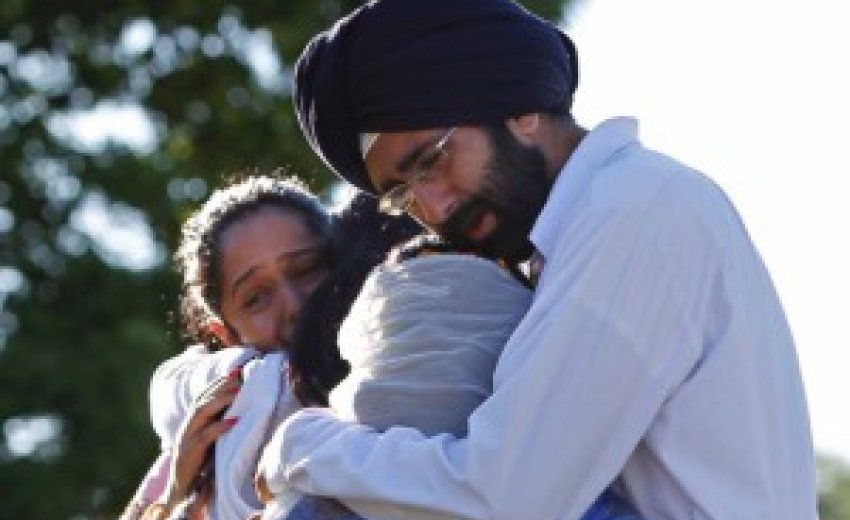Oak Creek, Wisconsin’s Sikh community received an overwhelming outpouring of support after six of their own were murdered in 2012 – but many say they are still afraid, and that things are getting worse
 |
| Mankirat Bhangu faced bullying and isolation in school. For Bhangu and other American Sikhs, the challenges that come along with wearing a turban persist into adulthood. Photograph: Neeta Satam |
Monday 28 December 2015:
![]() f it weren’t for the bullet hole in the doorway to the main prayer area and the police officer posted at the entrance of the Sikh Temple of Wisconsin, one might never know what happened.
f it weren’t for the bullet hole in the doorway to the main prayer area and the police officer posted at the entrance of the Sikh Temple of Wisconsin, one might never know what happened.
Nirmal Kaur had just pulled into the parking lot with her husband and children when the first shots rang out. That day in August 2012, a white supremacist killed six members of Oak Creek’s Sikh community, left another in an ongoing coma, and shot a police officer 15 times before killing himself. “I was so scared, and my children were crying,” Kaur said.
The attack – arguably one of the most violent acts ever committed against American Sikhs – drew a national spotlight onto the religious community that is often the victim of xenophobic harassment or attacks, many times due to the traditional beards and turbans worn by some Sikh men.
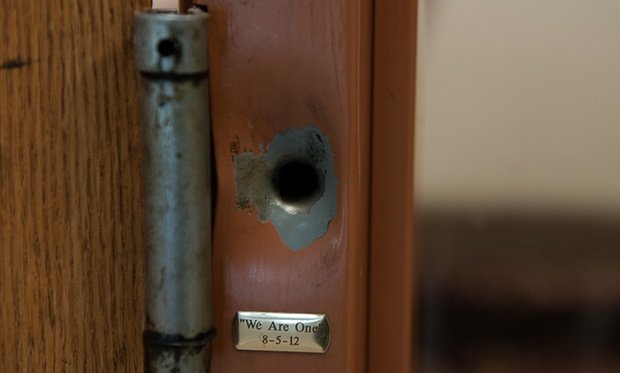 |
| A bullet hole remains in the doorframe of the prayer hall of the Sikh Temple of Wisconsin, where six Sikhs lost their lives in a mass shooting on 5 August 2012. Photograph: Neeta Satam for the Guardian |
Today, a small inscription below the inconspicuous bullet hole at the gurdwara (a Sikh house of worship) reads, “we are one.”
Kaur and most in Oak Creek’s Sikh community are quick to laud the outpouring of love and support they received from their fellow citizens of all faiths in the years following the attack, but many still say they feel unsafe, and that the climate of hate is only getting worse.
American Sikhs continue to report harassment, violence, and vandalism – particularly as backlash after terrorist attacks like that in San Bernardino, California.
“I don’t know if I feel any more safe,” Mandeep Kaur, a leader and activist in Oak Creek’s Sikh community, said of the gurdwara’s updated security procedures. “Your fear is not just within these four doors. What about when you step out of these four doors?”
“[Places of worship] are the places you should feel safe more than anywhere,” she added. “If you need a security guard, then I don’t know.”
It’s outside those walls where many instances of harassment or assault against American Sikhs do occur. Hundreds of hate crimes against Sikhs have been reported in recent years – more than 300 alone in the months following the 9/11 attacks in 2001.
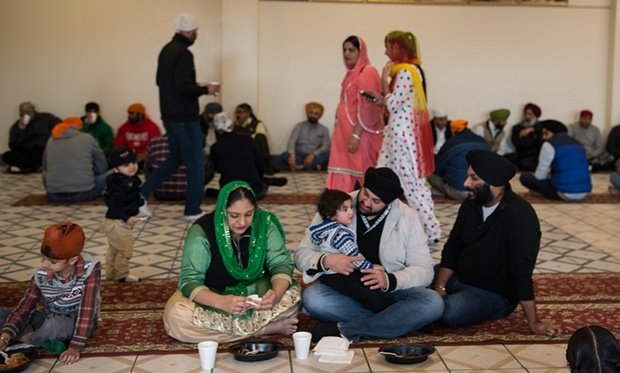 |
| A Sikh family, as well as other visitors to the temple, eats breakfast before prayers. Photograph: Neeta Satam for the Guardian |
“I have definitely seen a spike in hate crimes and violent incidents, particularly since the San Bernardino shooting,” said Harsimran Kaur, the legal director of the Sikh Coalition, a national group that advocates for the civil rights of American Sikhs. “It has created a really hostile atmosphere that I don’t think I’ve felt since after 9/11. It’s a really scary time right now for the community.”
Following the shooting, a gurdwara in Buena Park, California was vandalized with anti-Isis and anti-Islam graffiti. In Grand Rapids, Michigan, a Sikh gas station clerk was shot in the face after the gunman reportedly said, “I used to kill people like you in Iraq with no problem.” In Bakersfield, California, a 77-year-old Sikh man said someone threw an apple at his head so hard that it broke to pieces. Three Sikh men in San Diego, California were harassed when they tried to enter a football stadium.
Just days after the San Bernardino shooting, Prabhjot Singh and his two-year-old son were walking in midtown Manhattan when someone yelled “fucking terrorist” from a car, he said.
“I hear through a tight social network about incidents all over the country in our community, that are just growing in volume and regularity and normalcy,” Singh said. “Not only in our own community, but across a lot of minority communities. It’s definitely palpable.”
Singh made headlines in 2013 when he was attacked by a group of men in New York City who pulled on his beard and called him “Osama” before assaulting him, ultimately fracturing his jaw before passersbys intervened. That same group, Singh said, then attacked a Muslim woman who ended up in the emergency room with him. They had thrown a bottle of urine at her face.
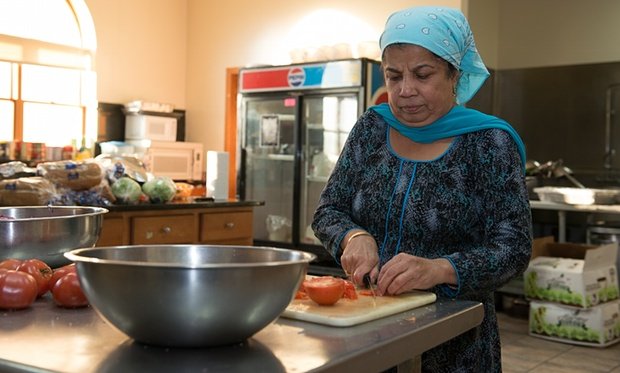 |
| Gurpal Kaur works in the pantry where 16 people took refuge in 2012. Kaur said she doesn’t wear a salwar kameez, a traditional dress, in public places, and has memorized all the exits to the temple. Photograph: Neeta Satam for the Guardian |
Rahul Dubey, a young American Sikh from Oak Creek who is active in interfaith advocacy – and whose godfather was one of the victims of the Oak Creek attack – said politicians are partially to blame, particularly when they fan the flames of Islamophobia that ultimately translate into attacks on Muslims, Sikhs and others who are perceived to be outsiders solely based on their religion or appearance.
“Sure, we are not Muslims,” Dubey said. “But what’s wrong with Muslims?”
Most Sikhs would answer, “nothing”. A monotheistic religion, Sikhs believe in the oneness of God and live in accordance to a philosophy that says all people are equal and must be respected. In Oak Creek and around the world, volunteers at gurdwaras routinely cook meals to be shared with the entire community. Everyone is welcome.
With at least 25 million followers worldwide – including an estimated 500,000 in the US – it is the fifth largest religion in the world. Believers follow the teachings of the 10 Sikh gurus – the belief of one creator God, selfless service and social justice, among others.
But most Americans don’t know that, even though Sikhs have been a visible part of American life for more than a century. A 2015 study by the National Sikh Campaign found that 60% of Americans report knowing nothing at all about the Sikh faith.
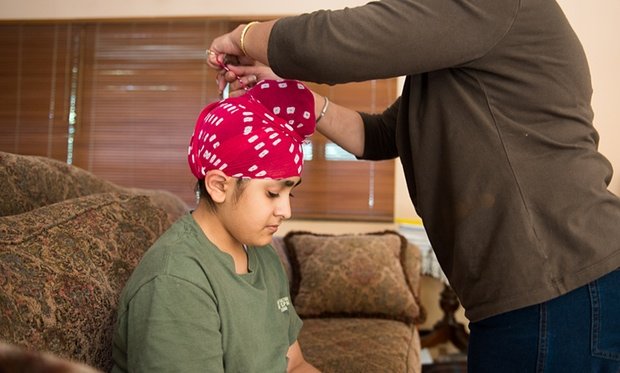 |
| Kuljeet Kaur drapes a ‘patka’ (head covering) around her 10-year-old son Simran’s head. Sikhs believe that keeping one’s hair is a sign of accepting what God has given. Photograph: Neeta Satam |
Nirmal Kaur placed part of that blame on the Sikh community itself.
“They cut their hair and took their turbans off,” she said, referencing the early Sikh immigrants to the US. “People didn’t recognize them. That’s why it’s getting worse.”
Born to a mixed Indian and Ugandan family in Uganda, Nirmal came to the US in 1985, eventually starting a family. She recalls her son coming home from school in tears, having been bullied because he did not cut his hair – a practice called kesh that some Sikhs keep as a symbol of respect for the perfection of God’s creation.
That’s how Nirmal got started giving presentations about Sikhism, mostly in classrooms or schools of her children or other family members – often with success, she said. After her son started getting bullied, she went to his classroom, demonstrated how she wraps his hair, and explained why. After that, she said, the bullying stopped.
“If middle school kids can understand this, then anyone can,” Nirmal said. “We can do this.”
 |
| Baljot Singh, six, practices writing in Punjabi at the Punjabi language school at the temple. Photograph: Neeta Satam for the Guardian |
For Harpreet Singh Saini, keeping his hair is a promise.
“I put my hand on my mom’s dead body and promised her that I was not going to cut my hair,” he said. His mother was one of the victims in the Oak Creek attack. “All we can do is fight the prejudice. There is nothing else we can do.”
“As I’m growing up, I’m glad I kept it,” said Manny Bhangu, a young Sikh from St Louis now living in Chicago, who recently graduated from acting school. Bhangu recalled occasionally considering cutting his hair – as some Sikhs do in order to reduce attention or harassment – but never did, even when a high school classmate of his called him a “fucking Iraqi” out the window of a car. “Middle school was tough,” he said. “I felt trapped to some level. At times, it was really, really heartbreaking.”
Sikh traditions have become a point of contestation in the armed forces as well. The US military prohibits facial hair and religious headgear, though makes case-by-case exceptions for those with sincerely held beliefs. There are currently only three observant Sikh men in the US military, and advocates are pushing for the policy to be abandoned.
Yet, despite the optimism and efforts to reach out to their neighbors, many say there is still a long way to go.
“I just want people to remember that this country was built on the contributions of immigrants, and unless you’re Native American you don’t have the claim to be an original American,” Harsimran Kaur said. “I just hope people remember that, and that the differences in our background in our faiths and our colors are what makes us stronger.”
Nirmal Kaur doesn’t have any plans to back down from her outreach any time soon, even as the number of attacks and instances of harassment continues to grow. She was just baptized in April – a ceremony that, in Sikhism, represents initiation into an order of followers who strictly adhere to all tenants of the faith, including wearing other visible articles of belief.
“I’m willing to go out and do this, even though I’m scared,” she added. “But God has written your death anyway. When you’re going to go, you’re going to go.”
